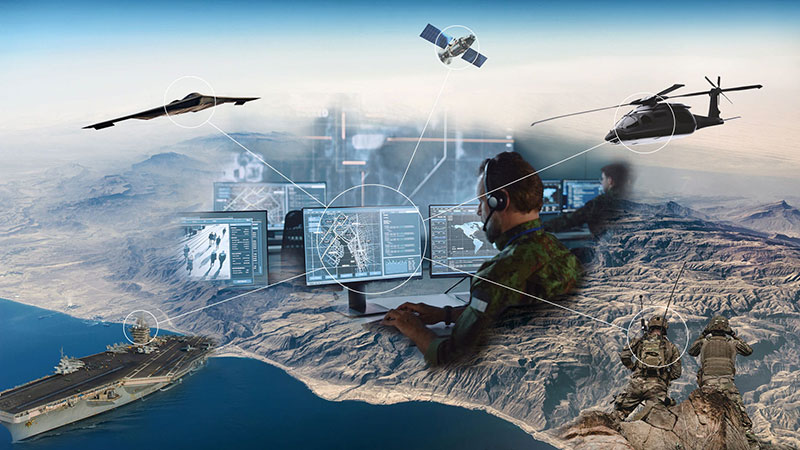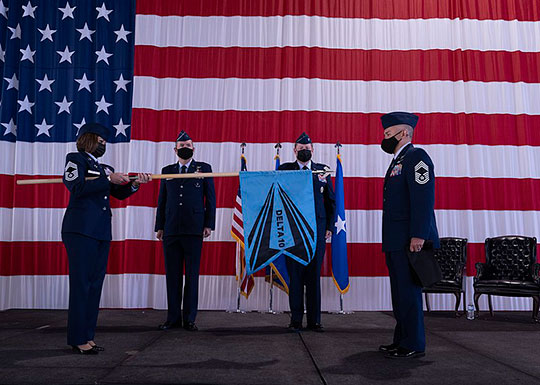
How are the new U.S. Space Force’s warfighters trained to fulfill their missions? Constellations spoke with Major General Shawn Bratton, Commander of the U.S. Space Force Space Training and Readiness Command (STARCOM) about training and developing its Guardians for the evolving space domain.
As STARCOM marks its one-year anniversary on being stood up as the latest field command for Space Force (alongside operations and acquisition), Bratton explained, “Combined together, it comes down to preparing the Space Force for competition and conflict in the space domain.”
One of the first priorities laid out by General Raymond, Chief of Space Operations, was to establish an independent professional military education for the Space Force. “General Raymond felt strongly that we need to grow independent Guardians. Take the best lessons, not just from the Air Force, but from the other services, and then define our own education."
Bratton said that taking recruits through basic training means thinking through what it means to be a Guardian, “everything from the kind of culture to the very technical aspects associated with space operations, and how to impart that.”
While it is pioneering a new domain, Bratton, a teacher by training, said STARCOM is learning and benefitting from what the Department of Defense, NASA and commercial companies are doing and bringing those best practices into the Space Force as it grows as part of the broader space industry.
Training that is different than Land, Sea, and Air
Another STARCOM priority Bratton highlighted is to create realistic training, range, and test environments to support the warfighter. To serve that purpose it is building out the National Space Test and Training Complex.
“That's our big technical challenge, creating the playground or gym to work out the force, and try out new capabilities and new tactics and techniques, and defining Space Force training.”
While other services can carve out dedicated real estate to test and train, as the Air Force does at Nellis Test and Training Range in Nevada and the Army at the National Training Center in California, the Space Force can’t simply declare a piece of space be set aside for testing and training purposes.
With satellites in orbit presenting challenges unique from land, sea, and air domains, the complex is being developed to help figure out how to operate, test, and train on a space range, Bratton said.
“Certainly, we can't do that in low earth orbit or in geosynchronous orbit, so we have to think about it differently, in how we meet our test and training objectives” Bratton said. “For things that we have to do live, how do we communicate that, and how do we think about safety and making sure our intentions are clear, so no one misunderstands the activity?”
Part of the answer, Bratton believes, lies in the advances in digital space, and the opportunity to do in simulation or a digital environment what doesn’t need to be done live.
“Lots of folks do this well, certainly NASA being one. We're trying to learn from and understand how they do test and training in the digital space and on simulators before they go live in a range-like environment.”
He spoke about NASA’s training capabilities that prepare astronauts for space missions, and the amount of preparation they do in the simulator to practice docking, for example. “What the astronauts relayed to me was, ‘That first live dock was almost just like that last dock in the simulator,’ meaning that the fidelity of the simulators and the level at which they're operating really prepares them for live space operations.”
But can Guardians be trained effectively for the demands of a contested mission in a simulated environment? Bratton framed the challenge in terms of weighing the value of live training versus training in a simulator. He acknowledged they don’t have all the answers yet but are learning from experts and working hard to establish an end state for the Space Force.
Size can also mean speed
While much of training can be set out in doctrine, there is still uncertainty in space given its pace of change, from new launches and new technologies to other dynamics. Asked how STARCOM can prepare Guardians for the unknown six months down the road, the answer came down to speed, like much else in the military. With 18,000 folks, Bratton considers the small size of the Space Force, which is a fraction of the other services, as an advantage. “Being such a small force lets us be really agile,” he said.
“One benefit that I think will prove out over time is the idea that with all of the training and education falling within a single organization, as something new happens we can introduce it right into the curriculum.”
As an example, he pointed to new guidelines issued last year for planning space operations, one of its first doctrine publications for the Space Force. “As soon as it came off the presses, we could hand it to the trainers and educators to incorporate immediately into the classrooms across the Space Force.
And so in responding to rapid innovation, whether within the department or industry, our small size will benefit our agility.”

A new flag
Although the Space Force is a distinct branch of the armed services, Bratton reiterated that it and the Air Force are of one department, organized in a manner similar to how the Marine Corps is organized under the Department of the Navy. “Secretary Kendall, the service Secretary for both Air Force and Space Force, relentlessly states, ‘one team, one fight’,” he said.
Each has its own Flag exercise, but are different, Bratton explained. While the Air Force Red Flag is a large, live-fly aircraft exercise with allies and other services flying simulated combat missions over Southern Nevada, Space Flag involves no live activity. “It is a limited use of simulation, using the capabilities that we have today,” Bratton said.
“It's more of a planning exercise where if the adversary does this, now what will you do? In some cases, we’re thinking through the tough problems, explaining it to the leadership, and then presenting the trainees with another challenging scenario.”
As for what’s next, Bratton explained a new series of Sky exercises; Black Skies, Red Skies, Blue Skies, each with four different communities. “So Black Skies, for example, will be for the electronic warfare community. Blue Skies will be for the cyber operators in the Space Force, and so on.
“A focus for us is to solve the training complex, the range problem first so we have a place to go take the force to work out and own our skills. And then you'll see us start to use those in both Space Flag and the Sky series as that comes online over the next few years.”
Click here to listen to the full interview.
